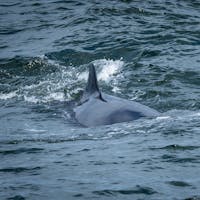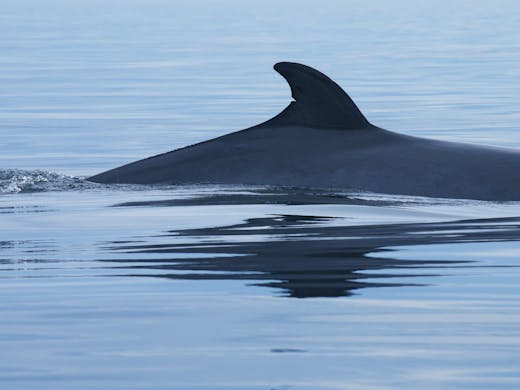Identifying Whales in Saguenay St. Lawrence Marine Park
A deep dive into the fascinating world of the whales commonly seen in Saguenay St. Lawrence Marine Park. Whether you have ever been on a whale watching tour in this region or if you are planning to embark on one soon, this article is made for you. The main goal is to equip you with the knowledge you need to identify each whale species, while also providing fascinating additional facts about these majestic creatures. In particular, I will delve into how marine biologists identify individual whales to gain deeper insights into their behavior and biology.
Saguenay St. Lawrence Marine Park
The Saguenay St. Lawrence Marine Park is located where the Saguenay River meets the St. Lawrence River. While the St. Lawrence River is commonly referred to as a river in this area, it is actually an estuary seamlessly transitioning into the Gulf of St. Lawrence later downstream. Even at the estuary of the Saguenay River, this area is abundant with marine wildlife, particularly during the summer months.
During the summer season, the Saguenay St. Lawrence Marine Park is visited by four common whale species: Beluga Whales, Minke Whales, Humpback Whales, and Fin Whales. On your whale watching tour, it's highly likely that you will encounter at least three of these magnificent creatures. With a stroke of luck, you might even catch a glimpse of the smallest all-year resident, the charming Beluga whale.
Along the North Coast, there are several harbors serving as departure points for whale watching tours. To enhance your experience, it's recommended to select a departure spot in close proximity to Les Bergeronnes or Les Escoumins. This is because the majority of whale sightings occur near the north-eastern end of the marine park. By choosing a departure location near these villages, you will minimize your boat journey and be able to get up close to the majestic whales more quickly.
Even in the summer months, it's advisable to bring warm clothing, as the coastal breeze can be chilly. If you are taking photos make sure having with you thin gloves as protection against the wind. And finally, it's important to note that the best time for whale watching in the area is during July and August.
Beluga Whales

Let's delve into each whale species, starting with the Beluga Whale (Delphinapterus leucas). These charming marine mammals are the smallest among the four species we will explore. Notably, they are year-round residents of the Saguenay St. Lawrence Marine Park, with a steady population of approximately 1500-2000 individuals.
Beluga whales, also known as White Whales, belong to the toothed whale family. They have a lifespan of up to 30 years. During their early years, their skin undergoes a remarkable transformation from gray to the iconic white. Beluga whales males reach a length of up to 5.5 meters.
Beluga whales are often observed in small pods, typically consisting of around 10 individuals on average. However, during the summer season, they can form larger gatherings numbering in the hundreds. It's worth noting that their primary predators, polar bears and killer whales, fortunately aren't present in the Saguenay St. Lawrence Marine Park.
In scientific research, individual Beluga whales are identified through meticulous examination of their distinct physical characteristics. These include the shape and size of their head, dorsal ridge, and tail. Researchers also rely on the presence of unique markings or scars on the whale's body, such as identifiable scratches or pigmentation patterns.
The defining characteristic that sets Beluga whales apart and aids in their identification is their distinctive white coloration. However, spotting Beluga whales can be challenging due to their small size and they often blend with the waves, especially when viewed against the sun.
Here's a helpful tip for spotting Beluga whales. If you find yourself in Tadoussac, take a short walk to the lighthouse on the peninsula near the harbor. This vantage point offers a great opportunity to witness Beluga whales as they enter the Saguenay River, making their way to the feeding grounds and nursery further upstream.
Fact Sheet
- Life Expectancy 30 years
- New Born 1.5m, 60kg
- Sexual Maturity 6-14 years
- Adult Male 3.5-5.5m, 1.1-1.9t
- Adult Female 3-4.1m, 0.7-1.2t
How to Identify
- White color
References
Minke Whales

Let's shift our focus to the next whale species, which happens to be challenging to identify - the Northern Minke Whale (Balaenoptera acutorostrata). These graceful creatures pay a visit to the Saguenay St. Lawrence Marine Park during the summer months and are typically observed either alone or in pairs, often consisting of a mother and her calf or juvenile.
These whales have a distinct appearance, with a black or dark grey coloration on their back and a contrasting light grey or white belly. Minke Whales boasts a life expectancy of about 30 to 50 years. Their prevalence in the marine park provides ample opportunities for visitors to observe and appreciate these magnificent creatures in their natural habitat.
The migration patterns of Minke Whales are not yet fully understood. However, they are known to arrive in the Saguenay St. Lawrence Marine Park in May and typically depart in October. While their specific migratory routes and behaviors remain a subject of ongoing research, it is fascinating to witness their seasonal presence in the park.
In scientific research, adult individual Minke Whales are identified by the presence of scars on their back and dorsal fin, often resulting from interactions with fishing nets, boats, or encounters with predators.
These distinctive marks serve as unique identifiers for researchers studying these whales. Based on my own study, I have observed that approximately 40% of adult Minke whales exhibit distinguishable marks on their dorsal fin.
For whale enthusiasts, identifying Minke Whales can be a challenge due to their resemblance to Fin Whales, another species found in the same area. However, there are distinguishing characteristics that set these two species apart. We will delve into these unique features later, helping you to confidently differentiate between Minke Whales and Fin Whales.
Fact Sheet
- Life Expectancy: 30-50 years
- New Born: 2.5m
- Sexual Maturity: 7-8 years
- Adult Male: 8.35m 7t
- Adult Female: 8.9m 8.25t
How to Identify
- Dark grey, black color
- White belly
- Small size
- Well formed dorsal fin
References
Humpback Whales

Moving on to the next whale species, we have the magnificent Humpback Whale (Megaptera novaeangliae), which are a common sight during the summer season and serve as the main attraction for tourists visiting the Saguenay St. Lawrence Marine Park. Humpback Whales typically arrive in the park around June and depart in October, providing a significant window of opportunity for visitors to witness their captivating presence.
Humpback Whales are indeed impressive creatures, reaching lengths of up to 17 meters. They possess a dark grey coloration, and one of their distinguishing features is their remarkably long pectoral fins, often referred to as flippers, which can span up to one-third of their body length. These flippers have a striking white coloration, creating a beautiful contrast against their dark grey bodies.
These awe-inspiring creatures can be observed either in pairs or small groups, and at times, they come together to form larger gatherings. In rare and extraordinary moments, lucky observers may have the opportunity to witness Humpback Whales engaging in fascinating behaviors such as flapping their massive flippers on the water's surface or breaching, which is when they leap out of the water and splash back in. These spectacular displays provide a truly memorable experience for those fortunate enough to witness them. It's a testament to the incredible agility and power of these magnificent creatures.
In scientific research, individual Humpback whales are identified through the unique pattern of white and grey on their tail, which is visible during their final submergence before diving. By capturing a photograph of a Humpback whale's tail, you can submit it to Happy Whale. The website utilizes photo identification techniques to match the individual to a known whale in their database. "Happy Whale" will then provide you with the name or number of the specific whale you encountered.
Moreover, by using the website, you can explore the whereabouts and sightings of the identified whale based on submissions from other whale enthusiasts.
The distinctive features that help us identify Humpback whales include their uniquely shaped dorsal fin and the characteristic display of their tail when they submerge for a dive. Among the three larger whale species, namely Minke, Humpback, and Fin Whales, the humpback whale stands out as the only one that showcases its tail in this manner.
Fact Sheet
- Life Expectancy: 50+ years
- New Born: 4.3m 680kg
- Sexual Maturity: 5-10 years
- Adult Male: 14-15m 40t
- Adult Female: 15-16.5m
How to Identify
- Shape dorsal fin
- Display fluke
References
Fin Whales

Let's delve into the final whale species commonly encountered in the Saguenay St. Lawrence Marine Park: the Fin Whale (Balaenoptera physalus). Ranking as the second-largest whale species worldwide, Fin Whales can reach impressive lengths of up to 22 meters and weigh up to 70 tons. Their sheer size is truly inspiring and captivates the imagination of those lucky enough to witness them in person.
The Fin Whale holds the title for being the fastest swimming of all whales, capable of reaching speeds up to 37 kmh, with bursts up to 46kmh. This remarkable speed has earned them the nickname "Greyhound of the sea".
When observed in the Saguenay St. Lawrence Marine Park, Fin Whales are typically seen in small groups ranging from 2 to 10 individuals. One notable aspect I have personally observed is their synchronized movement. Unlike some other whale species, Fin Whales exhibit a remarkable coordination as they gracefully navigate through the water at high speeds. It is a sight that truly showcases their strength and adaptability in their marine habitat.
In scientific research, individual Fin Whales are identified by examining features such as scars on their back and dorsal fin, as well as pigmentation patterns on their backs. While they may appear primarily grey in color, experienced observers can discern subtle patterns within the grey when analyzing photographs of individual whales.
However, it's important to note that individual identification of Fin Whales can be extremely challenging, similar to the identification process for Beluga whales.
Fact sheet
- Life Expectancy: 90+ years
- New Born: 6m 1.8t
- Sexual Maturity: 6-12 years
- Adult: 18.5-20m 38.5-50t
How to Identify
- Proportion Dorsal Fin / Body Size
References
Fin Whales vs Minke Whales
Now, to distinguish between Fin Whales and Minke Whales, consider the following differences:
- Coloring: Fin Whales generally have a lighter coloring compared to Minke Whales. While both species exhibit variations of dark grey on their back, Fin Whales tend to have a lighter shade overall.
- Group Size: Fin Whales tend to appear in groups larger than two individuals. In contrast, Minke Whales are commonly seen alone or in pairs.
- Blow/Fountain: When breathing at the surface, Fin Whales create a significant and impressive fountain-like spout. Minke Whales, while they do produce a spout, it is less prominent compared to that of the Fin Whales.
References
We need your help! By making a contribution towards our hosting costs, you can help us provide an ad-free experience on our website in the near future. Paypal
